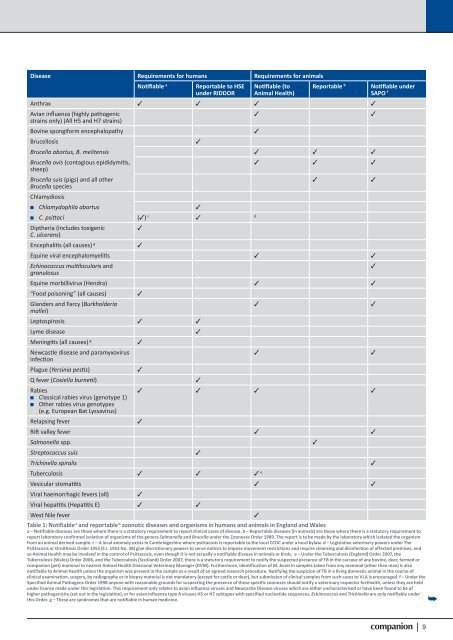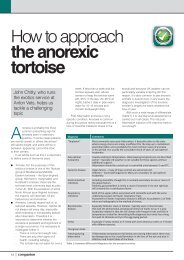Companion May 2012 - BSAVA
Companion May 2012 - BSAVA
Companion May 2012 - BSAVA
You also want an ePaper? Increase the reach of your titles
YUMPU automatically turns print PDFs into web optimized ePapers that Google loves.
Disease Requirements for humans Requirements for animals<br />
Noti fi able a Reportable to HSE<br />
under RIDDOR<br />
Noti fi able (to<br />
Animal Health)<br />
Reportable b Noti fi able under<br />
SAPO f<br />
Anthrax ✓ ✓ ✓ ✓<br />
Avian infl uenza (highly pathogenic<br />
strains only) (All H5 and H7 strains)<br />
✓ ✓<br />
Bovine spongiform encephalopathy ✓<br />
Brucellosis ✓<br />
Brucella abortus, B. melitensis ✓ ✓ ✓<br />
Brucella ovis (contagious epididymiti s,<br />
sheep)<br />
✓ ✓ ✓<br />
Brucella suis (pigs) and all other<br />
Brucella species<br />
Chlamydiosis<br />
✓ ✓<br />
■■ Chlamydophila abortus ✓<br />
■■ C. psitt aci (✓) c ✓ d<br />
Diptheria (includes toxigenic<br />
C. ulcerans)<br />
✓<br />
Encephaliti s (all causes) g ✓<br />
Equine viral encephalomyeliti s ✓ ✓<br />
Echinococcus multi locularis and<br />
granulosus<br />
✓<br />
Equine morbillivirus (Hendra) ✓ ✓<br />
“Food poisoning” (all causes) ✓<br />
Glanders and Farcy (Burkholderia<br />
mallei)<br />
✓ ✓<br />
Leptospirosis ✓ ✓<br />
Lyme disease ✓<br />
Meningiti s (all causes) g ✓<br />
Newcastle disease and paramyxovirus<br />
infecti on<br />
✓ ✓<br />
Plague (Yersinia pesti s) ✓<br />
Q fever (Coxiella burneti i) ✓<br />
Rabies<br />
✓ ✓ ✓ ✓<br />
■■ Classical rabies virus (genotype 1)<br />
■■ Other rabies virus genotypes<br />
(e.g. European Bat Lyssavirus)<br />
Relapsing fever ✓<br />
Rift valley fever ✓ ✓<br />
Salmonella spp. ✓<br />
Streptococcus suis ✓<br />
Trichinella spiralis ✓<br />
Tuberculosis ✓ ✓ ✓ e<br />
Vesicular stomati ti s ✓ ✓<br />
Viral haemorrhagic fevers (all) ✓<br />
Viral hepati ti s (Hepati ti s E) ✓ ✓<br />
West Nile fever ✓<br />
Table 1: Notifiable a and reportable b zoonotic diseases and organisms in humans and animals in England and Wales<br />
a – Notifiable diseases are those where there is a statutory requirement to report clinical cases of disease. b – Reportable diseases (in animals) are those where there is a statutory requirement to<br />
report laboratory confirmed isolation of organisms of the genera Salmonella and Brucella under the Zoonoses Order 1989. The report is to be made by the laboratory which isolated the organism<br />
from an animal derived sample. c – A local anomaly exists in Cambridgeshire where psittacosis is reportable to the local CCDC under a local bylaw. d – Legislative veterinary powers under The<br />
Psittacosis or Ornithosis Order 1953 (S.I. 1953 No. 38) give discretionary powers to serve notices to impose movement restrictions and require cleansing and disinfection of affected premises, and<br />
so Animal Health may be involved in the control of Psittacosis, even though it is not actually a notifiable disease in animals or birds. e – Under the Tuberculosis (England) Order 2007, the<br />
Tuberculosis (Wales) Order 2006, and the Tuberculosis (Scotland) Order 2007, there is a statutory requirement to notify the suspected presence of TB in the carcase of any bovine, deer, farmed or<br />
companion (pet) mammal to nearest Animal Health Divisional Veterinary Manager (DVM). Furthermore, identification of M. bovis in samples taken from any mammal (other than man) is also<br />
notifiable to Animal Health unless the organism was present in the sample as a result of an agreed research procedure. Notifying the suspicion of TB in a living domestic animal in the course of<br />
clinical examination, surgery, by radiography or in biopsy material is not mandatory (except for cattle or deer), but submission of clinical samples from such cases to VLA is encouraged. f – Under the<br />
Specified Animal Pathogens Order 1998 anyone with reasonable grounds for suspecting the presence of these specific zoonoses should notify a veterinary inspector forthwith, unless they are held<br />
under licence made under this legislation. This requirement only relates to avian influenza viruses and Newcastle Disease viruses which are either uncharacterised or have been found to be of<br />
higher pathogenicity (set out in the legislation), or for avian influenza type A viruses H5 or H7 subtypes with specified nucleotide sequences. Echinococcus and Trichinella are only notifiable under<br />
this Order. g – These are syndromes that are notifiable in human medicine.<br />
companion | 9



